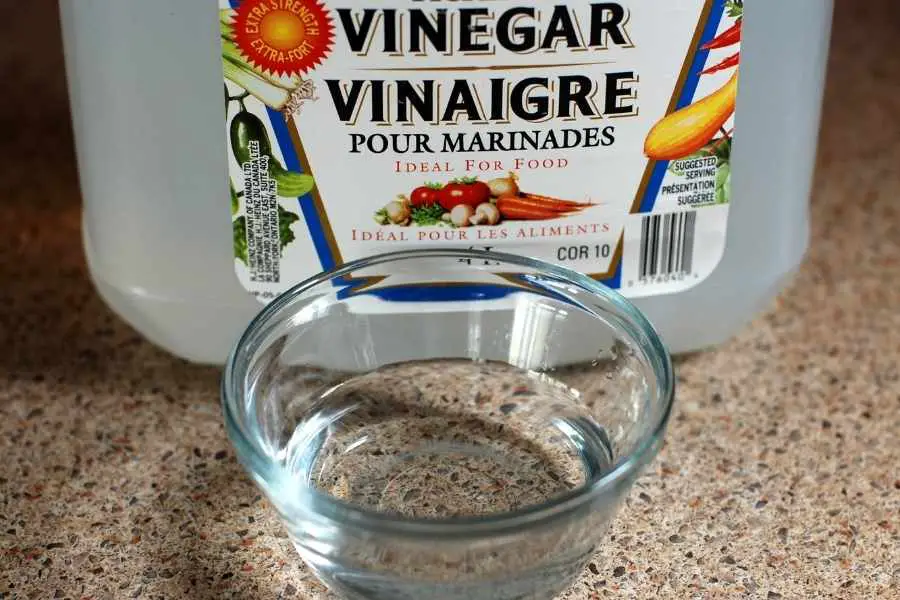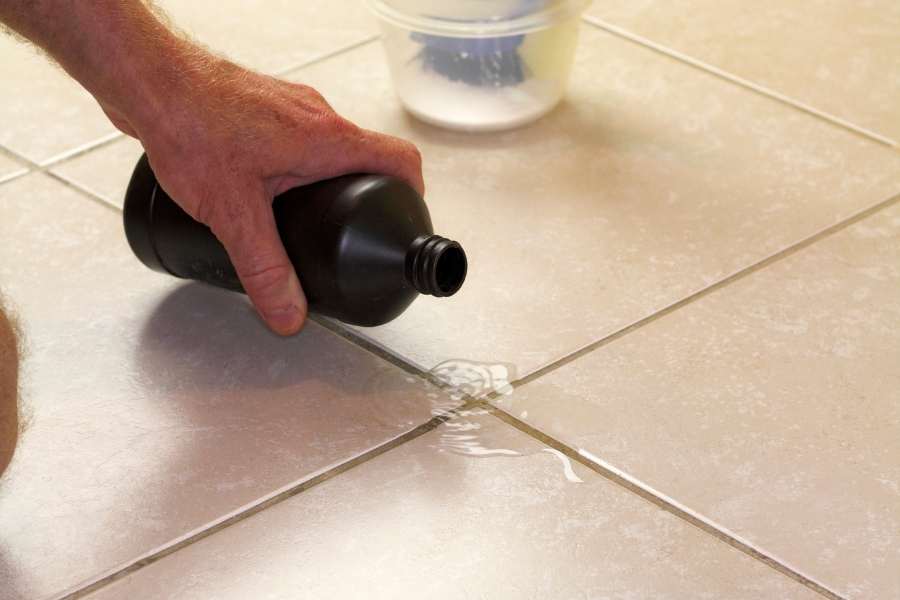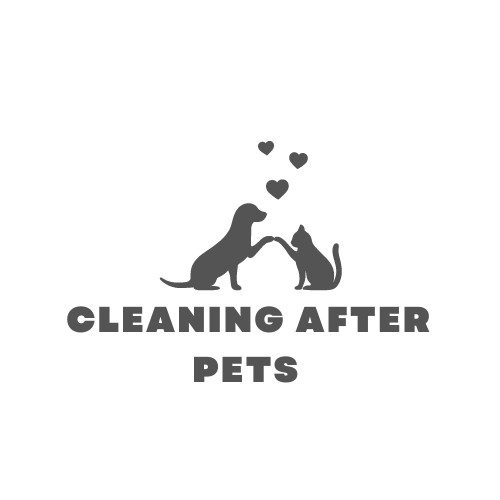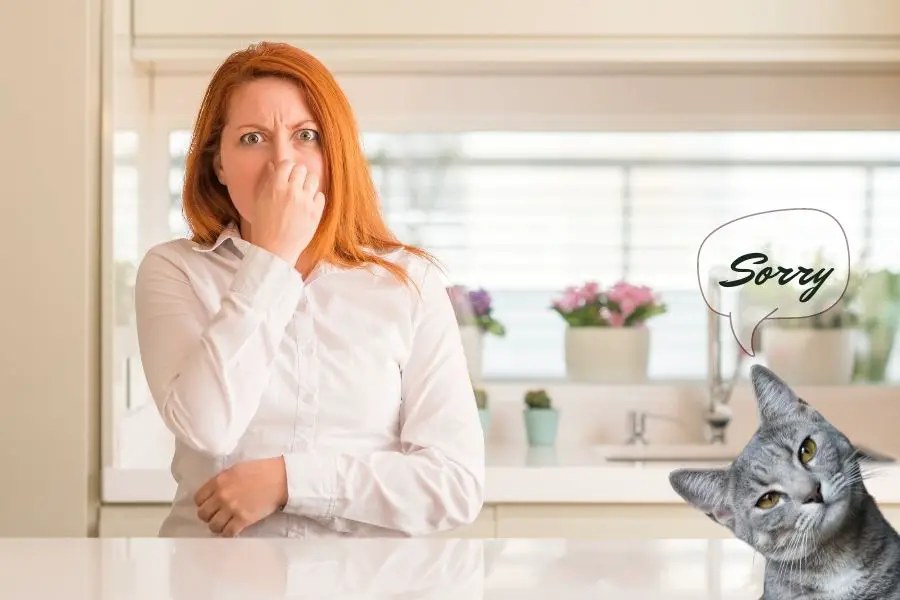Like other pets, cats are often a great source of joy in many homes. However, cat urine stain and odor can be tough to withstand when your whole house smells like cat urine. Ever wonder why your entire house smells like cat urine despite regular cleaning?
Well, it might be because you’re not cleaning the cat urine thoroughly.
Unfortunately, there are no shortcuts to cat urine stain cleaning – you have to clean the cat urine spot the right way to get rid of the odor in the air and your house. Merely covering it up with air fresheners, scented candles, and other fragrances that only provide short-lived relief will not cut it.
In this article, we will guide you through how to get rid of cat urine odor in the house. We’ll delve into finding the urine and using enzymatic cleaners and other products such as hydrogen peroxide to get rid of the urine.
Keep in mind that cats are ‘clean-freaks’ and will hate to use dirty litter boxes. Illness or social influence from other cats in the house and/or neighborhood may cause your cat (male or female) to spray, causing the whole house to smell like cat urine. Please read on to learn more.
Learn How To Stop Your Cat From Peeing In Your Home
How To Locate Cat Urine Stain In Your Home When Your Whole House Smells Like Cat Urine
Before you can clean and, where necessary, apply a post-cleaning treatment to the affected surfaces in your home, you’ll need to identify the location of cat urine stains and, by extension, the source of the odor. It can be a daunting challenge, especially if you are dealing with a dry cat urine patch that’s difficult to spot from afar.
You may have to check for cat urine stains underneath the furniture, below curtains, hidden areas of the house carpet, or in the soil holding your potted plants in the house.
Using a black light is the best way to locate cat urine stains on any surface, including the carpet, carpet padding, floor, and furniture. In most cases, it is difficult for the human eye to notice cat urine spots, especially if you have repeatedly cleaned and vacuumed the suspicious area.
Keep in mind that even after cleaning to get rid of cat urine, some uric acid may remain and crystallize, thereby remaining embedded in fabric fibers for many years.
How To Get Rid Of Cat Urine Odor Using Baking Soda
Baking soda is the most home DIY cleaning solution possible. It’s nonetheless effective in cleaning cat urine spots, especially on sensitive surfaces that would otherwise get damaged if you used harsher chemicals.
Cleaning with baking soda is most effective in cleaning carpets and floors.
Step #1: Prepare The Baking Soda Cleaning Solution
Mix a cup of baking soda with water. Add the water gradually and thoroughly mix the ingredients until you create a thick paste.
Step #2: Apply The Baking Soda
Apply the baking soda paste to the cat urine using a spatula. Using a scrubbing brush, brush the paste over the stain. After that, let the baking soda-covered stain air for 30 to 45 minutes.
Step #3: Vacuum, Rinse And Give The Surface A Final Wash
Vacuum up the baking soda to leave behind a clean and odorless surface. However, you might have to rinse residual baking soda until you get rid of all the traces of baking soda. After that, clean the surface with detergent and water.
How To Get Rid Of Cat Pee Smell Naturally Using Vinegar And Water
Cleaning with vinegar is an effective home solution. Vinegar (a dilute acetic acid) has acidic properties that can break down the urea and ammonia in cat urine spots.

Natural and DIY solutions for removing cat pee odor are ideal because they only require simple ingredients you can find in your home. A concoction of vinegar and water or vinegar and baking soda is especially effective when removing the less-stubborn cat urine stains and odors.
Vinegar and baking soda are most effective when dealing with fresh cat urine that has soaked carpet or floor.
For the task of cleaning your cat urine stains with baking soda and vinegar, you need the following:
- a spray bottle,
- vinegar,
- water, and
- wiping rags/paper towel.
Step #1: Dry The Wet Urine Patch
If you have to get rid of a wet/fresh cat urine patch, first blot the affected area using a rag or another absorbent material (such as a paper towel).
Soak up as much cat urine as possible before applying the baking soda paste to the fresh stain. Ensure you throw away the used rag immediately after use.
Cleaning Cat Urine Stains Soaked In Fabrics – If you need to remove a cat urine stain from the carpet, sprinkle some baking soda over the affected area and let it air for forty-five minutes to an hour to allow the baking soda to absorb the moisture.
Step #2: Prepare Your Vinegar-Water Cleaning Solution
Next, prepare your cat urine odor removal vinegar mix consisting of one part vinegar and one part water in a bowl and put the solution into the spray bottle.
Note! After preparing any homemade cleaning product, it is always prudent to try the solution on a hidden part of the surface before cleaning visible parts of your carpet, furniture, or other surfaces.
Step #3: Use your DIY Cat Urine Odor Removal Solution Made of Vinegar and Water
Spritz the solution on the stained area and allow the mixture to sit for 15 minutes to work on the cat urine or spray. Blot the vinegar-water mixture with a paper towel.
Pro Cleaning Tip – You may have to repeat this process until the cat urine stain and odor are gone. Additionally, use a vacuum cleaner to dry out the patch before reapplying the spray solution again to make your work easier.
Step #4: Blot the vinegar-water mixture with a paper towel.
You might have to repeat this process a few times to clear the cat’s urine odor. If the vinegar smell is overpowering, you can mask the smell by adding a drop or two of your favorite essential oil to the water-vinegar mix. Additionally, crank the windows open to let in fresh air.
How To Get Rid Of Cat Pee Smell Naturally Using Vinegar And Baking Soda
An alternative to using vinegar and water is to mix baking soda and vinegar for an even more powerful cleaning solution. Mixing baking powder causes a reaction that produces liquid water, carbon dioxide, sodium, and acetate ion.
The sodium and acetate ions combine to form sodium acetate, a powerful cleaning agent that dissolves the urine, eliminating the source of the urine odor.
You’ll the following ingredients to make your vinegar-baking soda DIY solution:
- vinegar
- baking soda
- water
- spray bottle
- paper towels or an old rug
Step #1: Mix 1 ½ cups of baking with ½ cup of water and 3 tablespoons of white vinegar in a spray bottle and allow it to effervescence.
Step #2: When the reaction is complete, spray the problem area and let it sit for 15 minutes before blotting up the area.
Step #3: Wipe the cleaning solution dry
Repeat as many times as necessary to clear up the odor.
How To Get Rid Of Cat Pee Smell Home Remedies – Hydrogen Peroxide
Hydrogen peroxide is another popular and accessible home item you can use for cleaning set in cat urine odor. It oxidizes the ammonia, eliminating the compounds that cause urine smell. Additionally, it destroys the bacteria, eliminating another cause of urine or spray odor.
If the urine spot is discolored, hydrogen peroxide can eliminate the discoloration.

You can dilute hydrogen peroxide with water in a spray bottle. You can add a few drops of soap to the resulting bottle if you want to scrub the urine spot.
Step #1: Test The Diluted Hydrogen Peroxide
Before using hydrogen peroxide, test it on an inconspicuous spot of the same material to ensure it does not cause discoloration. Whether you’re working on a carpet, tiled floor, wooden floor, or concrete floor, there is a potential for hydrogen peroxide to cause discoloration.
Step #2: Apply The Diluted Hydrogen Peroxide
Once you’ve tested the concoction to ensure it does not discolor the material you’re working on, spray the urine spot and let it sit for 5 minutes. Then wipe it out or vacuum it. Always ensure you remove any remaining hydrogen peroxide, as it can discolor the fabric, upholstery, carpet wood, or concrete surfaces.
Getting Rid Of Cat Urine Odor Using Baking Soda, Vinegar, And Hydrogen Peroxide The Safe Way
Using the combination of baking powder and vinegar might not work in some circumstances. You should use a more powerful cleaning method like hydrogen peroxide in such situations. Adding hydrogen peroxide to the cleaning process helps eliminate all the cat odor.
To eliminate the strong cat urine smell in the house using hydrogen peroxide, you need:
- hydrogen peroxide,
- vinegar,
- baking soda,
- dishwashing liquid, and
- old rags (or any other absorbent material).
Step #1: Dry The Wet Cat Urine Spot
If you’re cleaning a wet patch of cat urine, use an old rag to soak up as much cat urine as possible and discard the used towel.
Step #2: Absorb As Much Urine With Baking Soda
Apply your baking soda cleaning paste on the urine stain and allow it to air for about 20 minutes as it absorbs the moisture.
Step #3: Clean The Urine Spot With Vinegar
Add vinegar to the spot and allow effervescence to take place fully, which should take only a few minutes.
Next, dry the area as much as possible using another rag. Repeat the above steps until the stain is completely gone.
The next step is to eliminate any residue stains and odor using hydrogen peroxide.
Step #4: Get Rid Of Cat Urine Odor With Hydrogen Peroxide
Prepare a hydrogen peroxide cleaning solution of one or two drops of dishwashing liquid and two or three tablespoons of hydrogen peroxide. Pour the mixed solution onto the cat urine spot.
Remember to test your DIY solution on hidden parts of the material when dealing with fabrics. You want to know the effects of your concoction on the fabric before applying it somewhere that’s not hidden.
That way, you can avoid discoloring or ruining your home upholstery, curtains, wood floor, or any other item of materials.
After application, softly scrub the cleaning solution on the affected spot. Blot the cleaning solution with a paper towel or rug after a few seconds to avoid discoloring the material.
Apply the cleaning solution using a spray bottle when dealing with cat urine odor on hard surfaces such as wooden floors. Spray on the affected area and wipe the cleaning solution using an old rag.
NOTE: Never use hydrogen peroxide together with vinegar. The resulting reaction produces peracetic acid, which is toxic and corrosive and can break down fabric, concrete, and other surfaces it comes in contact with or applied to.
Using Enzymatic Cleaners For Cat Urine, Stain, And Odor

I keep smelling urine in my house even after cleaning the affected spots with homemade cleaning solutions. What do I do next?
It is time to move to a more specialized cleaning solution – enzymatic cleaners for cat urine.
Enzymatic cleaners are specialized cleaning solutions containing enzymes that break down the proteins in the cat’s urine, thereby eliminating traces of the urine (and its stain and odor). They are effective smell and stain removers from upholstery, carpets, rugs, and hard surfaces like floors.
Many Reddit users swear by enzyme cleaner as their go-to solution when dealing with old, stale cat urine.
While different brands use unique combinations of enzymes to manufacture their products, most enzymatic cleaners contain proteases.
Proteases speed up proteolysis, which breaks down complex long-chain protein molecules into shorter peptides, which are further broken down into the constituent amino acids. The resulting amino acids are easily consumed by bacteria and broken down into water and carbon dioxide.
The best overall enzymatic cleaner for cat urine is the ANGRY ORANGE Pet Odor Eliminator for Strong Odor. It has an orange after-smell, which helps impart a refreshing smell to ensure your cat does not use the spot to relieve itself. Additionally, you can use it to clean different materials and surfaces.
Alternatively, you can go for the BUBBAS Super Strength Enzyme Cleaner, renowned for its versatility. This industrial-grade enzyme cleaner can clean your laundry, carpets, hardwood floors, and more.
Other Examples of popular enzymatic include:
- Rocco and Roxie Professional Strength Stain and Odor Eliminator,
- Nature Miracle Advanced Stain and Odor, Pet Force, Pure Ayre, and
- Resolve Urine Destroyer Spray Stain & Odor Remover
With your chosen enzyme cleaner in hand, follow these steps:
Step #1: Dry The Urine Spot Completely
If you’re dealing with a wet patch of cat urine, blot the spot with an old rug until dry. If you’re using an enzymatic cleaner as a follow-up to your DIY solution, let the area of interest dry completely before applying the enzymatic cleaner.
Step #2: Apply Enzymatic Cleaner And Let It Air-Dry
Apply the enzymatic cleaner on the soiled part of the fabric, carpet, or floor and leave it to air-dry. During the drying process, the enzyme cleaner will accelerate the breakdown of the uric acid into peptides, which are easier to clean. Additionally, the evaporation that occurs will waft away some of the peptides.
Open the window and/or switch on the fan. You can place a portable fan near the soiled spot. The idea is to increase airflow to help the enzymatic cleaner evaporate, removing the peptides.
This is how to eliminate cat litter smell in apartments using enzymatic cleaners. Under normal circumstances, the urine stain and odor should dissipate once you use the enzymatic cleaner. However, if you still notice a faint cat urine smell, repeat the process several times until you completely remove the smell and stain.
Helpful Tip: Ensure the enzymatic cleaning product is safe for soft furnishings, carpets, wooden floors, or any other materials or surfaces you intend to clean before cleaning stained spots. Also, check the ingredients list on the enzyme cleaner to determine the stains it can remove.
Getting Rid Of Cat Urine Smell Using An Ozone Generator
Using oxygen generators to eliminate cat odor is a popular recommendation by Reddit cat owners. However, it is an easy and effective solution but must be used cautiously. You do not want to affect your neighbors, especially if you live in an apartment.
How does an ozone generator work? Ozone is naturally a very reactive compound. By generating ozone in a closed area, the O3 molecules react with different odor-producing particles in the air and house surfaces, breaking them into harmless, odorless compounds.
The ozone machine works well for both cat and dog urine odor.
With the above in mind, when buying an ozone generator, you must choose one suited to your home’s size and needs. Standalone, mobile ozone generators that use UV ozone generators will suffice in decontaminating indoor spaces. However, if the soiling is extensive, you can consider renting a higher-capacity ozone generator, such as an industrial-grade ozone generator.
You could even invest in a larger-capacity ozone generator to use around your home (and not necessarily to clear pet mess). For instance, the OdorFree Estate 4000 Ozone Generator has the capacity to deodorize a 4,000-square-foot space, getting rid of pets, food, smoke, and other types of odors in confined spaces.
The FDA, EPA, and the American Lung Association recommend only using ozone in unoccupied spaces. Additionally, you should wait at least two hours before reoccupying the space.
When the machine is done, open the windows and doors to let any ozone dissipate—for the living space to be safe again.
Cleaning The Cat Urine On Different Areas/Surfaces And Materials
A well-trained cat will always be comfortable using its litter box. However, when your cat is sick or stressed (more on this below), it will soil the floor, carpet, curtains, or other surfaces. Different surfaces and materials will necessitate a different cleaning method.
Some surfaces and materials are a tad sensitive and require cleaning methods that will not corrode the material or the surface. Other materials allow the urine to soak deep into the materials, requiring a cleaning solution to reach deep into the materials and neutralize the urine to eliminate the smell.
In a nutshell, no method will be universally effective in cleaning all surfaces and materials. You have to pick and choose the best solution for a particular material and/or surface.
Learn more about cleaning different surfaces and materials in the links below:
- How To Get Rid Of Cat Pee Smell On Wood, Concrete, And Other Hard Surfaces
- How To Get Rid Of Cat Pee Smell On Wood Furniture
- How To Get Rid Of Cat Pee Smell On Carpet
- How To Clean Cat Litter Out Of Carpet
- How To Get Cat Pee Out Of Your Suitcase
- How To Get Cat Pee Out Of Bedding
- How To Keep Litter Box From Smelling Up The House
- How to Get Cat Urine Smell Out of Clothes
The Don’ts Of Cleaning Cat Urine Odor In Your House Or Apartment

As you know by now, getting rid of cat urine odor can be daunting. As such, you don’t want to mess things up. Taking the wrong approach to clean cat urine exacerbates the awful smell or, even worse, makes the odor permanent in your house or apartment.
With that in mind, below are the don’ts of cleaning strong cat urine smell in house:
- Never steam clean the urine spot. In the same light, never apply heat over the affected area. Steam and/or heat can set the stain, making it difficult to treat/remove. If you must use your laundry machine, use a cold spin cycle to clean the garment. Additionally, do not machine-dry the garment.
- Don’t use cleaning solutions and detergents that contain ammonia as an ingredient. The after-smell of ammonia might encourage your cat to continue peeing in the same spot.
- Finally, restrain yourself from punishing your cat harshly. Whether the cat is dealing with an ailment, stress, or anxiety, the last thing you want to do is make your cat more anxious. The increased anxiety will likely worsen its condition, making them prone to peeing accidents.
How Long Does Cat Urine Odor Last
How long does it take for cat urine to fade? The odor can last forever if left in place. The uric acid component of the cat urine does not wash away once it soaks into the floor, carpets, garments, wood, or any other materials on the surface.
The uric acid crystallizes once the urine patch dries, allowing the foul smell to dissipate somewhat. However, it reconstitutes when the crystals come into contact with water (for instance, water vapor from the air during a humid day), allowing bacteria to act on it and decompose. That’s why cat urine odor seems to disappear and appear regularly.
Due to the uric acid, cat urine odor persists if you don’t use appropriate cleaning methods. Additionally, you should do a thorough job of cleaning all the crystals.
Why Your Cat Is Peeing Outside The Litter Box

While cleaning urine spots will eliminate the pungent cat urine smell, you should also learn why your cat is soiling in your home. Unless you treat the underlying cause of the soiling problem, you will most likely find yourself cleaning cat litter in the future.
On the other hand, if you treat the underlying cause of the soiling problem, you’ll negate the risk of soiling again. So, why is your cat soiling your home?
Your Cat May Be Sick
It is essential to determine if your cat is experiencing stress levels or health disorders such as Urinary Tract Infection (UTI), causing it to pee outside the litter box. The best way to ascertain your cat’s health condition is to visit a trusted vet for an examination. You can read more about cat UTIs and home remedies in this article.
Social And Behavioral Influence From Other Cats
Social influence from other cats can also impact your cat’s bathroom habits. For instance, when confronted by unfamiliar cats in the neighborhood, unneutered male cats will spray around the house to mark their territory. On the other hand, female cats spray around the house when on heat and try to attract a male cat to mate.
The Litter Box’s Design, Cleanliness And/Or Placement Could Be The Problem
Litter Box Design – The design and choice of the litter box can significantly impede your efforts to get rid of the foul-smelling cat urine odor. Look for a spacious litter box with a good design and portability to make it easier to clean the litter box thoroughly.
Cleanliness – Your cat may go outside the litter box to express displeasure with it. You may not like the smell of ammonia in your cat’s litter box, but neither will your cat. It is best to clean the litter box to reduce the cat’s risk of soiling your carpet, curtains, or garage.
Ensure You Have A Schedule For Cleaning The Litter Box – Cleaning the litter box haphazardly or with a ‘devil-may-care’ attitude could be why your cat hates going to the litter box. Apart from cleaning the litter box well, you should scoop at least once daily to keep the house free of cat poop and pee odor.
After scooping the waste, place it in a plastic bag and tie the bag entirely and take it outside the house.
Litter Box Placement – Finally, you should also consider the placement of the litter box as a probable cause of your cat shying away from its litter box. Cats are generally comfortable relieving themselves in low-traffic or hidden, quiet, and easily accessible spots. If you’ve placed your cat’s litter box in an open place full of traffic, it will naturally shy away from it, even when trained to use a litter box.
Place The Litter Boxes Strategically – Consider moving the litter box to a more private but accessible spot to prevent your whole house from smelling like cat urine. We also advise cat owners to consider buying extra litter boxes and placing them strategically in their homes, including the garage, for extra convenience when your cat needs to go to the bathroom. Try to put the litter boxes in places the cat frequents.
Which Is the Best Choice Of A Litter Box?

A good litter box is necessary for any house with a cat. Ensuring you have a high-quality litter box is often the first step to dealing with a cat urinating inside your home. For instance, an old-clay litter box works fine absorbing garage oil but will do little to contain cat urine odor in your home.
The best cat litter box will have the following qualities:
- Adequate size with a simplistic design
- Easy to scoop and clean
- Sufficient anti-tracking pellets
- Allows you to change the pads once per week and pellets once per month
- With pad having super-absorbent qualities to trap the ammonia smell for up to seven days
Case Study: The Purina Tidy Cats Breeze Cat Litter System
The design of the litter box can help significantly. For instance, the Purina Tidy Cats Breeze Cat Litter System has cat litter box pads to lock in moisture and ensure the box is always dry.
Additionally, this litter box uses an advanced pellets system and disposable pellets capable of separating solids and liquid, ensuring solid cat poop stays “afloat.” It allows the pet owner to scoop easily and dispose of the poop.
Simultaneously, this litter box ensures cat urine is locked in the pads below the box; these pads have super-absorption qualities.
What Smells Deter Cats From Peeing?
Cats rely on their olfactory senses a great deal. For instance, when they urinate somewhere, they use that scent to identify urinating spots. Consequently, if you don’t clean the urine spot thoroughly and get rid of the order, they will urinate on the same spot in the future.
Your cat’s keen olfactory senses can help deter it from peeing in certain places. Cats hate strong scents such as mint, citrus, vinegar, cinnamon, rosemary, and coffee and will avoid soiling areas with such strong scents.
Conclusion
Cat urine has uric acid that is not soluble in water. This is why the urine odor persists despite extended washing with water soap alone. Our tips on how to get rid of cat urine odor in the house will help you deal with situations where your whole house smells like cat urine. Importantly, these cleaning methods will help you deal with cat urine, whether it smells like ammonia, burnt rubber, or any other nuance odors.
You must be prepared to deal with accidents if you have a cat. Remember that you need to take a wholesome approach involving finding the accident spot, cleaning it thoroughly, and taking steps to prevent the accident from occurring again.
With this guide, you can come up with the right products and effective cleaning strategies for how to get rid of cat odor in the house.

